S. Mansourian, A. Belokurov and P.J. Stephenson
Stephanie Mansourian is a Consultant, Gingins, Switzerland.
Alexander Belokurov is Manager, Landscape Conservation, and Peter J. Stephenson is Director, Conservation Strategy and Performance, World Wide Fund for Nature (WWF) International, Gland, Switzerland.
Protected areas are even more important for biodiversity conservation and human livelihoods in a world with a changing climate.
The relationship between forests and climate change is intricate. On the one hand forests can mitigate climate change by absorbing carbon, while on the other they can contribute to climate change if they are degraded or destroyed. In turn climatic changes may lead to forest degradation or loss – which exacerbates climate change further.
A protected area is defined as: “A clearly defined geographical space, recognized, dedicated and managed, through legal or other effective means, to achieve the long-term conservation of nature with associated ecosystem services and cultural values” (Dudley, 2008). Forest protected areas help conserve ecosystems that provide habitat, shelter, food, raw materials, genetic materials, a barrier against disasters, a stable source of resources and many other ecosystem goods and services – and thus can have an important role in helping species, people and countries adapt to climate change. By virtue of their protective status, these forests should remain free from destructive human intervention. They can thus continue to serve as a natural storehouse of goods and services into the future.
Today climate change is one of the main emerging threats facing biodiversity. Up to a quarter of mammal species (about 1 125) (IPCC, 2002) and about 20 percent of bird species (about 1 800) (IPCC, 2007) are at risk of global extinction because of climate change.
Protected areas that were set up to safeguard biodiversity and ecological processes are likely to be affected by climate change in a number of ways. Climate change is expected to cause species to migrate to areas with more favourable temperature and precipitation. There is a high probability that competing, sometimes invasive species, more adapted to a new climate, will move in. Such movements could leave some protected areas with a different habitat and species assemblage than they were initially designed to protect. For example, Scott (2005) found that a stated objective of Prince Albert National Park in Saskatchewan, Canada, to protect ecological integrity “for all time”,is unrealistic, as all possible climate scenarios project the eventual loss of boreal forests and their related biodiversity in that area. Climate change is expected to lead to disease outbreaks as pest species may become more resistant or survive longer and new pest species may invade protected areas. For instance, Pounds et al. (2006) have traced the much publicized extinction of the Monteverde harlequin frog (Atelopus sp.) and the golden toad (Bufo periglenes) in the Monteverde forest of Costa Rica nearly two decades ago to warming in the American tropics which is thought to have favoured a particular fungus that infected the amphibians. Climate change is also likely to lead to a higher incidence of fire in some situations and floods in others (IPCC, 2007).
In many cases, the negative effects of climate change on protected areas will be compounded by other stresses, notably those caused by humans, for example through overconsumption, pollution or encroaching urbanization. Biodiversity in protected areas that may already be vulnerable because of these human threats may be more quickly or more severely affected by climate change.
With these and other likely changes, the management of existing protected areas will need to be modified if they are to fulfil their biodiversity conservation role as well as support adaptation to climate change.
This article explores the importance of forest protected areas for ecological, social and economic purposes, drawing on examples from the work carried out around the globe by the World Wide Fund for Nature (WWF) in the context of climate change. It focuses on the broader spatial context and the landscapes within which protected areas are found. It then proposes a range of management and policy responses to ensure that forest protected areas can continue to support biodiversity conservation in the face of climate change.
| In a changing climate, protected areas will take on added importance as safe havens for biodiversity by offering good-quality habitats less vulnerable to climate extremes (African buffalo, Syncerus caffer – a species susceptible to drought conditions – in Ngorongoro Conservation Area, United Republic of Tanzania) |
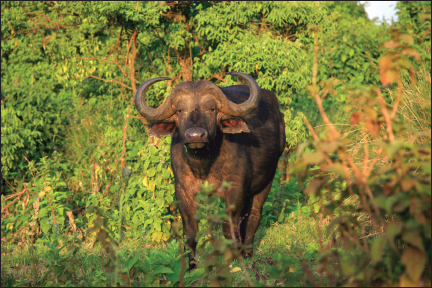 |
A. Belokurov, ImageNature |
Protected areas have been recognized for several decades as an essential tool for conserving biodiversity. The impacts of climate change now give them a renewed role as adaptation tools for a changing climate. Their importance in this respect is threefold:
The world now has over 100 000 protected areas, of which the terrestrial ones cover 12.2 percent of the earth’s surface (UNEP-WCMC, 2008). Protected areas can be among the most effective tools for protecting species from extinction and from the impact of human-induced threats. If well planned and managed, they can contribute to biodiversity conservation by:
In the creation of most protected areas and in the identification of sites that achieve targets for habitat and species representation to date, a relatively constant climate has been assumed (Hannah et al., 2007). However, as the climate changes, plans and assumptions about protected areas need to be reconsidered (McCarty, 2001). Areas for future conservation efforts need to be assessed in the face of different climate change scenarios, and the current protected area network needs to be reviewed to ensure that it can deliver intended conservation results and help mitigate negative climate change impacts.
In a changing climate, protected areas will take on added importance as safe havens for biodiversity by offering good-quality habitats less vulnerable to climate extremes, by providing refuges for threatened species and by conserving important gene pools. It will also become more important to protect reference landscapes – ecosystems on which restoration planning is based, and which provide a basis for evaluating the success of restoration (Sayer, 2005).
Networks of protected areas within large-scale landscapes will help accomplish the fourth point above, providing resilience to climate change. Landscape planners can help biodiversity adapt to changing conditions by carefully defining and managing connections or corridors between protected areas, removing or preventing barriers such as roads or monoculture plantations of trees or agricultural crops and creating “stepping stones” for particular species (Figure).
To ensure the survival of priority plant and animal species targeted for conservation, it will be important to obtain new information on their:
This information can then be overlaid with predicted climate scenarios so that action can be taken to safeguard biodiversity.
For example, because of the added threat of climate change to African elephants and their habitat, the implementation of the WWF Species Action Plan for African elephants (Stephenson, 2007) will include climate vulnerability assessments for elephant populations using available assessment tools (Hannah, 2003). The results will be used to develop and implement climate change adaptation strategies for elephant landscapes identified as being at high risk. The Amazon’s unique biodiversity is also expected to be under significant threat from climate change; a loss in the viability of numerous plant species, specifically in the northeastern Amazon, is expected by 2095 under all climate scenarios (Miles, 2002).
| Protected areas in a landscape |
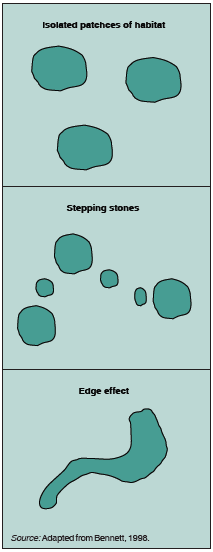 |
| Because of the added threat of climate change to African elephants and their habitat, the WWF Species Action Plan for African elephants includes climate vulnerability assessments for elephant populations (Tarangire National Park, United Republic of Tanzania) |
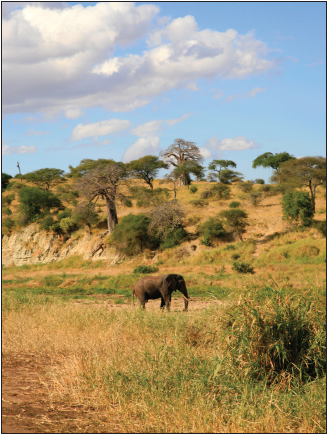 |
A. Belokurov, ImageNature |
Protected areas may provide ecosystem services such as drinking water, carbon storage and soil stabilization; harbour sacred sites for different faith groups; and hold important gene reservoirs of value in medicine, agriculture and forestry. In the face of climate change these roles all become more critical to enhance the adaptive capacity of local people to cope with climate change (Simms, 2006).
Protected areas, by helping to maintain natural ecosystems, can contribute to physical protection against major disasters, which are predicted to be on the rise with climate change (Scheuren et al., 2007). Although the scale of disasters generally depends on an aggregation of factors (e.g. building regulations, land use), in many cases ecosystem maintenance and forest protection can greatly reduce their impacts. Coastal mangroves, coral reefs, floodplains and forests may buffer land, communities and infrastructure against natural hazards. For example, during the Indian Ocean tsunami in 2004, vegetation-covered coastal sand dunes at Yala and Bundala National Parks in Sri Lanka completely stopped the waves and protected the land behind them (Caldecott and Wickremasinghe, 2005). Some protected areas also provide an opportunity for active or passive restoration of traditional land use practices such as agroforestry and crop terracing, which may help mitigate the impacts of extreme weather events in arid lands, for example by reducing the risk of erosion and by maintaining soil structure (Stolton, Dudley and Randall, 2008).
In addition, protected area management can help empower marginalized human populations or community groups. Alternative forms of protected area governance such as community conservation or joint management, for example, are being implemented to reduce conflicts over land and to promote long-term maintenance of protected areas for provision of benefits to stakeholders. A case in point is the “Parks with People” policy developed in Bolivia in 2005 to engage indigenous communities in management of protected areas (Peredo-Videa, 2008).
| Protection of coastal mangroves can help ensure their provision of physical defence against major disasters, which are predicted to be on the rise with climate change (Sundarbans National Park, Bangladesh) |
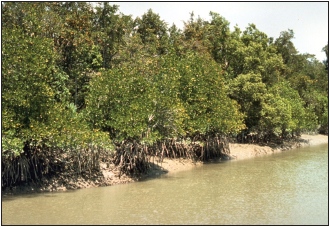 |
FAO/FO-0316/T. Loosli |
If a country’s natural habitat is destroyed by climate change impacts, its economy will suffer. A recent study (Dasgupta et al., 2007) found that the gross domestic product (GDP) of a number of countries, led by Viet Nam, could be negatively affected by sea level rise, saltwater intrusion and natural disasters attributed to climate change. In helping to protect natural habitat, protected areas indirectly help to protect the national economy.
In addition, protected areas can provide a direct means of enhancing revenue, notably through tourism, but also through the valuable products they harbour and the services they provide. For example, Guatemala’s Mayan Biosphere Reserve provides employment for over 7 000 people and generates an annual income of approximately US$47 million (PCLG, 2002). In Madagascar, a study of 41 reserves found that the economic rate of return of the protected area system was 54 percent, essentially from watershed protection and to a lesser extent from ecotourism (Naughton-Treves, Buck Holland and Brandon, 2005). Thus, protected areas provide a safety net which can be valuable in times of stress, such as extreme climate events.
The loss of protected areas may lead to significant costs, for example infrastructure damage and human tragedy caused by desertification or tsunamis, or to loss of revenue, from tourism for instance. Furthermore, deforestation of major forest blocks, such as the Amazon, is thought to have an impact on global rainfall, which in turn affects agriculture and therefore the livelihoods of millions of people (Nepstad, 2007). Protected areas therefore not only help protect biodiversity, but also indirectly contribute to the planet’s food security.
| The potential loss of protected areas may lead to loss of revenue, from tourism for example (Iguazu Falls National Park, on the border between Brazil and Argentina, one of the top destinations in South America with nearly 2 million tourists a year) |
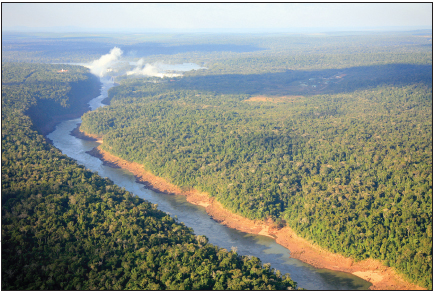 |
A. Belokurov, ImageNature |
Protected area managers, and the broader conservation community, will need to consider climate change in considering future management actions. Already, most conservation agencies have taken on board the need to factor climate change into their planning. For example, in 2008 WWF embarked on a new global conservation strategy (WWF, 2008a) which includes not only biodiversity goals but also a major focus on humanity’s “ecological footprint” (demand on the biosphere in terms of the area of biologically productive land and sea required to provide the resources used and to absorb the waste produced by society). Addressing climate change is a key objective.
In addition to using the creation of protected areas and the number of hectares of threatened habitat under protection as indicators for measuring progress in achieving conservation goals, protected area management will need to address the following additional dimensions to take account of climate change.
A well-planned protected area network is necessary if species that are present in few fragmented patches of habitat, in small numbers or at the limits of their range are to adapt to climate-related changes. Size, shape and altitudinal gradients all contribute to a protected area’s resilience to climate change and to species’ freedom of movement. Optimally designed protected area networks should reduce barriers and obstacles between protected areas. They should incorporate buffers, connections, corridors and stepping stones for the movement of animal species across the landscape and abundant good habitat across a vast range of altitudes, so that in times of stress species can move to more favourable environments within the relative safety of a protected area. In Borneo, for example, WWF and partners are seeking to secure a network of protected areas in a 240 000 km2 landscape which has an altitudinal gradient of more than 4 000 m, to enable species to move between different habitat types (WWF, 2008b).
In seeking to maintain a representative network of ecosystems, it is no longer safe to assume that all of a species’ historic range remains suitable in a changing climate. As noted above, under future climate scenarios many of the current protected areas will no longer be able to fulfil their role of protecting representative habitat for species targeted for conservation. A modelling study in Mexico, the Cape region of South Africa and Western Europe indicated that with a moderate increase in temperatures, extensive new protected areas would be needed to achieve representativeness (Hannah et al., 2007). In this regard the Convention on Biological Diversity’s Programme of Work on Protected Areas (CBD, 2004) urged great expansion of the protected area network across the globe to secure long-term representativeness of ecosystems and help species adapt to climate change. In subsequent years the world’s protected areas have expanded exponentially, but the expansion needs to continue.
Effective management is essential to climate adaptation. Protected area management to ensure adaptation to climate change may include restoration, focusing on resilient habitats, managing specifically for anticipated threats such as fire and pests, and addressing other threats (which can be exacerbated by climate change). Restoration will be important both within protected areas and around them in targeted locations within the wider landscape. WWF adopts a forest landscape restoration approach in which key elements of the landscape are identified for restoration to achieve multiple objectives and make the whole landscape more functional in meeting environmental, social and economic objectives (Mansourian, Vallauri and Dudley, 2005). In the lower Danube basin in Bulgaria, for example, WWF and partners have focused on restoring floodplain forests to ensure that this biological corridor, important for spawning fish as well as nesting and migratory birds, can withstand climate change (WWF, 2002). Since ancient habitats that have withstood variations in climate to date may be more likely to endure future changes, WWF is also working with local authorities in Chile to ensure protection of the resistant Valdivian forest which has trees over 3 000 years old.
Future protected area management strategies and plans should also include options for carbon storage as well as reducing emissions from deforestation and degradation. Regular assessments of management must be a priority so that interventions can be adjusted if necessary.
In a future in which more people will be vying for fewer resources, and where climate change is likely to cause a greater strain on both people’s livelihoods and the availability of resources, protected areas will only be viable if they are directly relevant to human communities that live in or depend on them (Borrini-Feyerabend, Kothari and Oviedo, 2004). Protected areas contribute less to livelihood strategies in practice than they could in theory. In the future, design and management plans for protected areas will need to focus more on local community engagement, linkages with the national development agenda and alternative forms of protected area management such as private-sector or community management. Governance schemes for protected areas may need to be modified for greater effectiveness and for conflict resolution. Decision-makers need to ensure that institutional and legal conditions enable people to benefit directly from protected areas.
| In a future stressed by climate change, protected areas will only be viable if they are directly relevant to human communities that live in or depend on them (sustainable honey production by a local women’s group in a forest reserve in Zambia) |
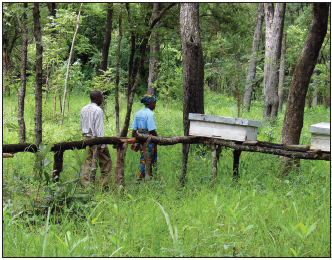 |
A. Belokurov, ImageNature |
While future climate change scenarios and local impacts remain uncertain, protected areas will surely be affected. However they can also play a significant part in adaptation to climate change. Improving climate resilience and adaptation will require changes in the approach to protected area planning, establishment and management. Moreover, it is critical to reduce global greenhouse gas emissions and to keep the temperature rise within a 2ºC limit. If these are not achieved, adaptation will never be sufficient.
![]() Bibliography
Bibliography
Bennett, A. 1998. Linkages in the landscape: the role of corridors and connectivity in wildlife conservation. Gland, Switzerland, World Conservation Union (now International Union for Conservation of Nature) (IUCN).
Borrini-Feyerabend, G., Kothari, A. & Oviedo, G. 2004. Indigenous and local communities and protected areas: towards equity and enhanced conservation. Gland, Switzerland & Cambridge, UK, IUCN.
Caldecott, J. & Wickremasinghe, W.R.M.S. 2005. Sri Lanka: post-tsunami environmental assessment. Nairobi, Kenya, United Nations Environment Programme (UNEP).
Convention on Biological Diversity (CBD). 2004. Programme of Work on Protected Areas. Montreal, Canada.
Dasgupta, S., Laplante, B., Meisner, C., Wheeler, D & Yan, J. 2007. The impact of sea level rise on developing countries: a comparative analysis, World Bank Policy Research Working Paper 4136. Washington, DC, USA,World Bank.
Dudley, N., ed. 2008. Guidelines for applying protected area management categories. Gland, Switzerland, IUCN.
Hannah, L. 2003. Regional biodiversity impact assessments for climate change: a guide for protected area managers. In L.J. Hansen, J.L. Biringer & J.R. Hoffman, eds. Buying time: a user’s manual for building resistance and resilience to climate change in natural systems, pp. 235–244. Berlin, Germany, World Wide Fund for Nature (WWF).
Hannah, L., Midgley, G., Andelman, S., Araújo, M., Hughes, G., Martinez-Meyer, E., Pearson, R. & Williams, P. 2007. Protected area needs in a changing climate. Frontiers in Ecology and the Environment, 5(3): 131–138.
Intergovernmental Panel on Climate Change (IPCC). 2002. Climate change and biodiversity, ed. H. Gitay, A. Suárez, R.T. Watson & D.J. Dokken. IPCC Technical Paper V. Geneva, Switzerland & Nairobi, Kenya, World Meteorological Organization (WMO) & United Nations Environment Programme (UNEP).
IPCC. 2007. Climate change 2007 – impacts, adaptation and vulnerability. Contribution of Working Group II to the Fourth Assessment Report of the IPCC. Cambridge, UK, Cambridge University Press.
Mansourian, S. 2006. Joining the dots: species and protected areas – A contribution to the CBD Programme of Work on Protected Areas. Gland, Switzerland, WWF.
Mansourian, S., Vallauri, D. & Dudley, N., eds. 2005. Forest restoration in landscapes: beyond planting trees. New York, USA, Springer.
McCarty, J.P. 2001. Ecological consequences of recent climate change. Conservation Biology, 15: 320–331.
Miles, L.J. 2002. The impact of global climate change on tropical forest biodiversity in Amazonia. PhD thesis, Centre for Biodiversity and Conservation, School of Geography, University of Leeds, Leeds, UK.
Naughton-Treves, L., Buck Holland, M. & Brandon, K. 2005. The role of protected areas in conserving biodiversity and sustaining local livelihoods.Annual Review of Environment and Resources, 30: 219–252.
Nepstad, D. 2007. The Amazon’s vicious cycles: drought and fire in the greenhouse. Gland, Switzerland, WWF.
Noss, R. 1992. The Wildlands Project: land conservation strategy. Wild Earth,Special Issue: 10–25.
Peredo-Videa, B. 2008. Climate change, energy and biodiversity conservation in Bolivia – roles, dynamics and policy responses. Policy Matters,16: 163–174.
Pounds, J.A., Bustamante, M.R., Coloma, L.A., Consuegra, J.A., Fogden, M.P.L., Foster, P.N., La Marca, E.,
Masters, K.L., Merino-Viteri, A., Puschendorf, R., Ron, S.R., Sánchez-Azofeifa, G.A., Still, C.J. & Young,
B.E. 2006. Widespread amphibian extinctions from epidemic disease driven by global warming. Nature, 439: 161–167.
Poverty and Conservation Learning Group (PCLG). 2002. Sustainable harvesting of non timber forest products for the conservation of the biosphere reserve in Guatemala. Case Study C0035. London, UK, International Institute for Environment and Development (IIED). Available at: www.povertyandconservation.info/biblio/C0035
Sayer, J. 2005. Goals and targets of forest landscape restoration. In S. Mansourian, D. Vallauri & N. Dudley, eds. Forest restoration in landscapes: beyond planting trees, pp. 101–108. New York, USA, Springer.
Scheuren, J.-M., le Polain de Waroux, O., Below, R., Guha-Sapir, D. & Ponserre, S.
2007. Annual disaster statistical review: the numbers and trends 2007. Brussels, Belgium,Centre for Research on the Epidemiology of Disasters (CRED).
Scott, D. 2005. Integrating climate change into Canada’s National Parks System. In T. Lovejoy & L. Hannah, eds. Climate change and biodiversity, pp. 343–345. New Haven, Connecticut, USA & London, UK, Yale University Press.
Simms, A. 2006. Up in smoke? Latin America and the Caribbean: the threat from climate change to the environment and human development. 3rd report, Working Group on Climate Change and Development. London, UK, New Economics Foundation.
Stephenson, P.J. 2007. WWF Species Action Plan: African elephant, 2007–2011. Gland, Switzerland, WWF.
Stolton, S., Dudley, N. & Randall, J. 2008. Natural security: protected areas and hazard mitigation. Gland, Switzerland, WWF.
United Nations Environment Programme – World Conservation Monitoring Centre (UNEP-WCMC). 2008. State of the world’s protected areas: an annual review of global conservation progress. Cambridge, UK,
World Wide Fund for Nature (WWF). 2002. Forest landscape restoration: working examples from 5 ecoregions. Brochure. Gland, Switzerland.
WWF. 2008a. WWF Global Programme Framework 2008–2020. Gland, Switzerland.
WWF. 2008b. WWF Heart of Borneo Network Initiative Strategic Plan. Gland, Switzerland.